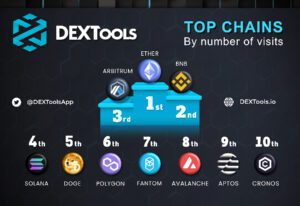
In its exponential technological growth in functionalities for DeFi trading, DEXTools offers users (as of today) more than 70 blockchains available and easily accessible through its handy App. We list here the top 10 in the ranking, according to the number of users:
1-Ethereum (ETH). It is a decentralized, open-source platform that enables developers to build and deploy decentralized applications (dApps) and smart contracts. It also has its own cryptocurrency, Ether (ETH), which is used to pay for transaction fees and computational services on the network.
2-Binance (BNB). It is currently the world’s biggest crypto exchange in terms of trading volume, and it provides a variety of crypto trading pairs and services like spot trading, margin trading, futures trading, and staking. It has its own token (BNB), which can be utilized for various purposes, such as covering trading fees and other services on the Binance platform.
3-Arbitrum (ARB). It is a solution developed to address the scalability issues of the Ethereum blockchain. It operates as a layer 2 scaling solution, which enables developers to construct decentralized applications (dApps) that are more efficient and less expensive to operate.
4-Solana (SOL). It is a blockchain network for high-frequency trading and decentralized applications (DApps) that is quick, safe, and censorship-resistant. Proof of History (PoH), a unique consensus technique used by Solana, enables validators to handle transactions in parallel without having to wait for confirmation.
5-Dogecoin (DOGE). Originally, Dogecoin was created as a humorous cryptocurrency inspired by the Doge meme. Transactions on the Dogecoin blockchain are validated by a network of nodes in a decentralized manner. Unlike Bitcoin, Dogecoin’s supply is not limited, which means there is no cap on the number of Dogecoins that can be created.
6-Polygon (MATIC). It enhances Ethereum’s scalability as a Layer 2 scaling solution. It is a sidechain that operates alongside the Ethereum mainnet, providing faster and more cost-effective transactions with higher throughput. To achieve its scaling objectives, Polygon enable transactions to be conducted off-chain and then securely settled on the Ethereum mainnet, leading to lower congestion and gas fees.
7-Fantom (FTM). This blockchain platform is constructed in order to deliver rapid transaction speeds and excellent scalability. Its goal is to facilitate the creation of secure, interoperable, and cost-effective decentralized applications (dApps) and smart contracts.
8-Avalanche (AVAX). It is a blockchain network that intends to provide quick transaction speeds, low transaction costs, and high scalability. The goal of this platform is to enable secure, interoperable, and customizable dApps and smart contracts. It provides resources for developers, including a developer suite, APIs, and compatibility with other blockchains.
9-Aptos (APT). It is a blockchain platform that operates using a Proof of Stake consensus mechanism. The platform employs the Move programming language for its smart contracts, which is highly flexible and prioritizes safety. It also emphasizes horizontal scaling, which helps alleviate network congestion as it grows.
10-Cronos (CRO). This blockchain operates using the Ethereum Virtual Machine (EVM) to support decentralized applications (dApps). Its primary aim is to offer developers a scalable and cost-effective solution for building and deploying dApps on the Cosmos network, without the need to abandon their Ethereum-based assets.







